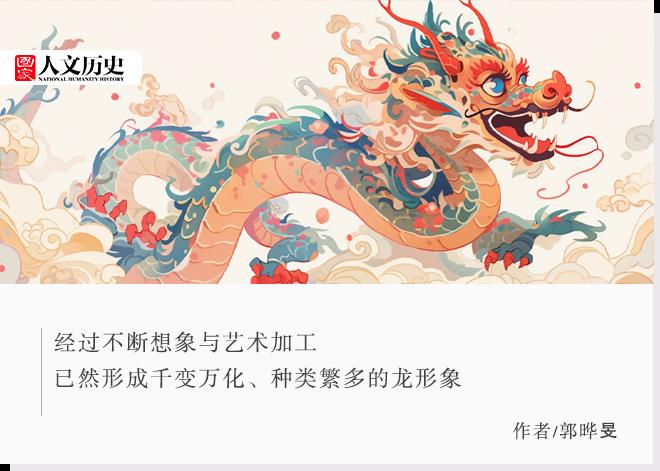
This article is about 5600 words.
Reading takes 15 minutes.
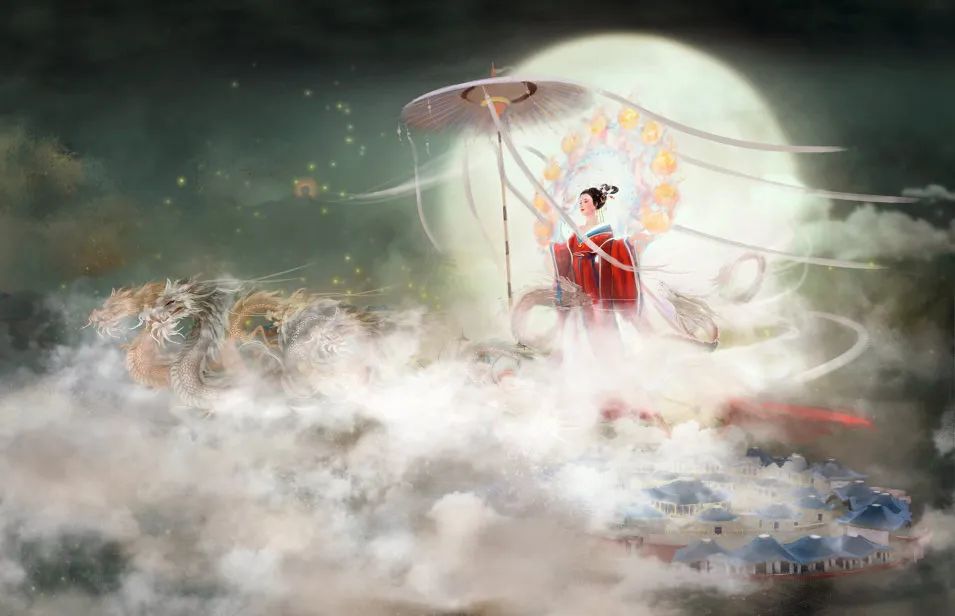
Xi he Imperial Day, illustration, modern, Yan Xiaonan. Xi he is both the god of the sun and the god of making calendars. Gao You said in the note "Huainanzi Astronomical Training": "Ride by car every day, drive with six dragons, and xi he will control it."
It is generally believed that the dragon is an imaginary animal that does not exist in reality. However, human imagination is not rootless water, and any imagination must have its realistic prototype. Which animal did the dragon originate from in nature?
Dragon and snake entanglements
There have always been different opinions on the above question, including crocodile theory, lizard theory, snake theory, pig theory, dinosaur theory, hippo theory and horse theory, etc. At present, there is no conclusion. Among these animals, the relationship between snakes and dragons is quite intriguing. Dragons, like snakes, have long curved bodies that can be coiled and stretched.(The difference is that dragons have enough but snakes don’t). In many ancient books, dragons and snakes often go hand in hand. "Under the Yi Cohesion" records that "the trend of dragons and snakes is to survive"; In the Eastern Han Dynasty, Wang Chong also said that "the dragon is like a snake, and the snake is like a dragon" in "On Balance and Telling Rui". Later, Bao Puzi, a book written in the Eastern Jin Dynasty, clearly pointed out: "There are dragons of nature, and there are dragons transformed from snakes." This sentence shows that at least some dragons evolved from snakes. So far, people have always called snakes "little dragons". In folklore, there is a story about the mutual change of dragons and snakes. It is said that there is a dragon in Tanzhe Temple in Beijing, which flew away on a stormy night, leaving two snake-like "dragons". In addition, there is a Bailong Temple on Mount Emei in Sichuan. Although the temple is named after the dragon, it commemorates the white snake in The Legend of the White Snake.(White Snake).
About because of this origin, the phenomenon that snakes and dragons are mixed and called is common in ancient books. People can often find the image of "human head snake body", such as Fuxi and Nu Wa. The Han Fu "Lu Lingguang Dian Fu" contains: "Fuxi scales, Nuwa snake body." Guo Pu, a native of the Eastern Jin Dynasty, wrote in The Classic of Mountains and Seas and the Wild West Classic: "Nu Wa, an ancient goddess and emperor, has a snake-faced body, which changes from seventy to seventy in a day, and her abdomen becomes this god." Fuxi and Nu Wa are also snake heads in the Silk Painting of Fuxi Nu Wa Tu unearthed from Astana Tomb in Turpan, Xinjiang. "Liezi Huangdi" yue:
"Dong offer’s?(Fuxi), Nuwa, Shennong(Yan Di)Xia Houshi, a snake with a human face, a bull’s head and a tiger’s nose: this is inhuman and has the virtue of a great sage. "
Apart from Nvwa 、 Fuxi and Emperor Yan, there are many mythical figures in China who are also human heads and snakes. For example, "phase liu, nine faces, snake body and green", "Gong Gong, snake body and Zhu Fa" and so on. The most striking thing is that "Shan Hai Jing Overseas Western Classic" records: "The country of Xuanyuan … in the north of women’s country, people face the snake, and the tail meets the head." "Xuanyuan" is the title of Yellow Emperor. In the Ming Dynasty, Tao Zongyi said that Xuanyuan was "a dragon with a head" in Shuo cymbals. The same god is sometimes called "snake body" and sometimes called "dragon body". This proves that the two refer to the same thing, that is, the "snake body" is the "dragon body".
For such a phenomenon, Wen Yiduo thought in Fuxi Kao in his early years:
"The dragon totem, whether it is like a horse, a dog, a fish, a bird or a deer, is a snake in its trunk and basic form, which shows that in the era when many totem units were in the first place, the snake totem was the most powerful among them, and the merger and melting of many totems was the result of the merger and assimilation of many weak units."
From the viewpoint of "dragon and snake are integrated", among the many fairy animals with different forms and characteristics recorded in Shan Hai Jing, which can be regarded as a master of ancient myths, there are many who have "dragon bodies (snake bodies)". For example, "Shan Hai Jing Nan Shan Jing" says: "From Tianyu Mountain to Nanyu Mountain, every 14 mountains, 6,530 miles, have a dragon body and a human face." When offering sacrifices to these mountain gods, a white dog is used as a sacrifice, and the polished rice used for the sacrifice is glutinous rice. "Shan Hai Jing Zhongshan Jing" is the cloud:
"Every shouyangshan, surrendered to the mountain as for the third mountain, jiusan, two hundred and sixty-seven. Its gods are all dragons and faces. "
The practice of offering sacrifices to these mountain gods is different. To preside over the sacrificial ceremony, a rooster should be buried in the ground as a living sacrifice. Cereal grains such as millet, millet, rice, sorghum and wheat should be used as the refined rice for sacrifice. In Shan Hai Jing Bei Shan Jing, the "dragon with a human face" becomes a "snake with a human face". The so-called "from the mountain of a single fox to the dike mountain, where there are 25 mountains and 5,490 miles, their gods are all snake with a human face". When offering sacrifices to these gods, a rooster and a pig used as sacrifices should be buried in the ground, and a jade Jue should be used in the beautiful jade for offering sacrifices to the gods, only buried in the ground without using rice for offering sacrifices. The most peculiar thing is the mountain gods in Shan Hai Jing Nan Shan Jing: "Where the South Second Classic is the first, from Guishan to Qiwu Mountain, where there are seventeen mountains, 7,200 miles, their gods are all dragons and birds." The appearance is different, and the way of sacrifice is naturally different. When offering sacrifices to these mountain gods, a jade jade must be buried in the ground with the sacrificed livestock, and the refined rice for the sacrifice should be used.
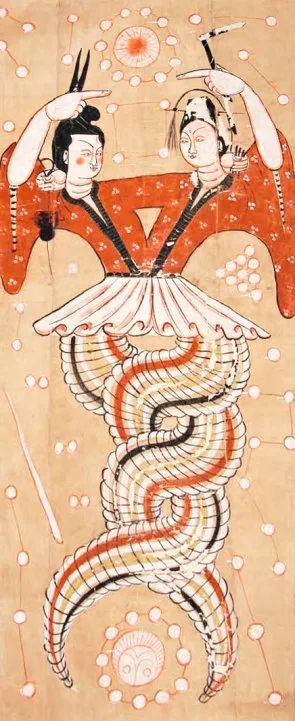
The picture of Fuxi Nuwa, in Tang Dynasty, is colored in silk, with a length of 220 cm and a width of 116.5 cm. It is now in the Museum of Xinjiang Uygur Autonomous Region and was unearthed in Astana cemetery in Xinjiang in 1965.Fuxi and Nu Wa in the painting are the images of human heads and snake bodies.
In addition to these four-sided mountain gods, there are also records of "dragon (snake) body" gods in Shanhaijing, Xishan Classic and Overseas North Classic. For example:
"There is a god, and the human head is snake-shaped, long as a shaft, with a head on the left and right, purple clothes and a crown, which is called Yanwei."
"phase liu, nine faces, snake and green. Dare not shoot north, afraid of the stage of gong gong. Taiwan is in its east. "
In The Classic of Mountains and Seas, phase liu is a courtier of the water god Gong Gong. He can eat food from nine mountains, and the land he passes through becomes a swamp, making it difficult for birds to live and causing floods. By the way, phase liu appeared in the Hollywood movie "Fantastic Night at the Museum 3" ten years ago, but his image was depicted as a nine-headed python. In fact, this is not in line with the statement of "human head and snake body" in Shan Hai Jing.
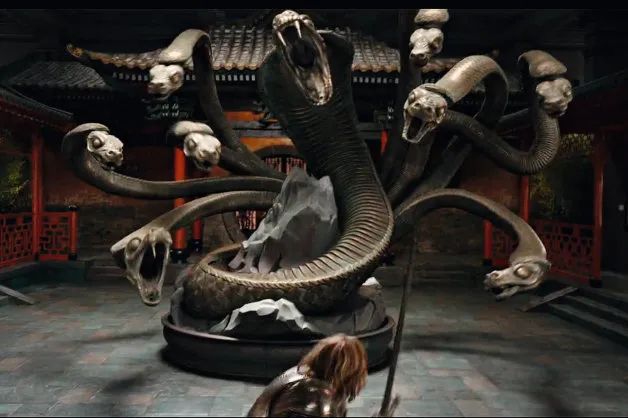
Stills of the movie "Fantastic Night at the Museum 3". The prototype of Hydra comes from phase liu, who wrote "Nine human faces, the snake is green" in Shan Hai Jing. The film depicts it as a nine-headed python, which is actually not in line with the statement of "human head snake body" in Shan Hai Jing.
"Ying Long" has wings.
Shan Hai Jing, of course, does not lack the records of "complete form" dragons. The so-called "complete form" is the dragon image that people are familiar with today, that is, the "dragon has nine similarities" summarized by Luo Yuan in Er Ya Yi in Song Dynasty."Dragon, with horns like deer, head like camel, eyes like rabbits, neck like snakes, abdomen like salamanders, scales like fish, claws like eagles, palms like tigers, ears like cows."If the dragon grows wings again, it is called "ying"Dragon ". For example, Guo Pu notes: "Ying Long, the dragon has wings", and "Guangya Release Fish" also records: "Ying Long is called with wings."
There are also many records of Ying Long with wings in Shan Hai Jing. For example, The Wild North Classic records that when Chiyou led a group of monsters to attack the ground of Zhuolu under the jurisdiction of the Yellow Emperor, the Yellow Emperor first ordered Ying Long to go out to fight. Ying Long is good at storing water, and plans to drown the ranks of Chiyou in Jizhou wilderness with huge rain. Unexpectedly, the cunning Human-God was ready, so he invited Fengbo Rain Master to take the lead in setting up a big storm. Ying Long’s power was hard to exert for a while. When the Yellow Emperor saw it, he sent his heavenly daughter "Hao" to help. "Hao" has the ability to stop the wind and rain. At that time, Ying Long and Chi-you took advantage of the storm, unable to withstand it, and were defeated and killed. From the historical perspective, the battle between Huangdi and Chiyou was naturally early.The struggle between human tribes can never be assisted by gods as in the Romance of Gods. Ying Long, Chi-you, and even Fengbo Rain Master of Chi-you were probably just the names of the tribes at that time. Among them, the tribe named "Ying Long" takes some kind of winged dragon as its totem.
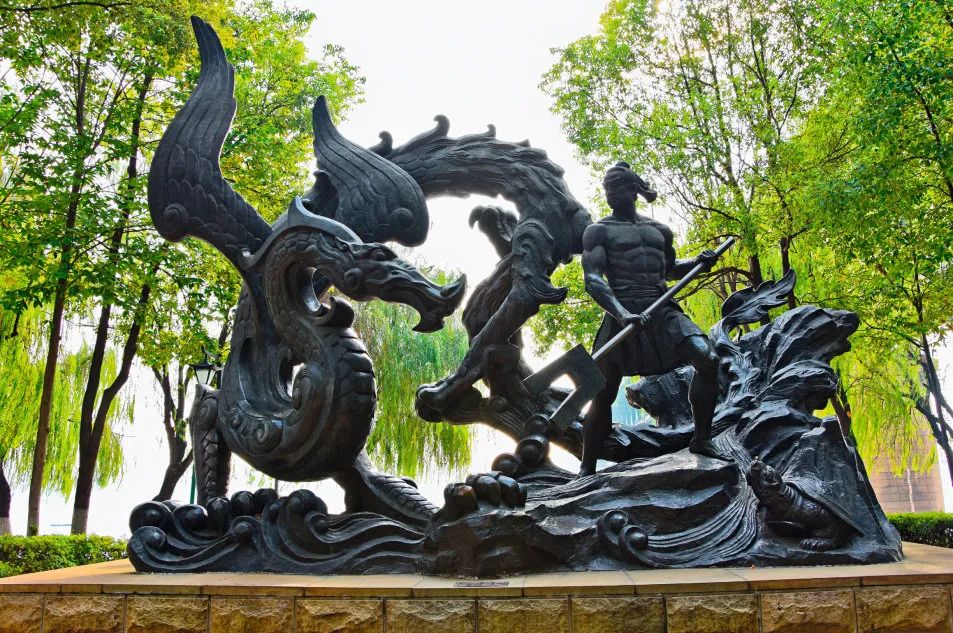
"Ying Long Painting Rivers", a sculpture, is located in Dayu Mythological Garden in Wuhan. The heckling words in "The Songs of the South" link Ying Long and Dayu’s water control. Dayu "tried his best to ditch the river and guide Sichuan and Yiyue", and Ying Long was ordered to open the way ahead. It draws the land with its tail, and wherever it is drawn, the river road it opens extends to where it is drawn.
In Shan Hai Jing, next, Ying Long pushed on and met Kuafu. Kuafu is a well-known mythical figure. Shan Hai Jing Da Huang Bei Jing recorded: "Kuafu overreached himself, and wanted to pursue the scenery of the sun and caught it in Yugu. I will drink the river but not enough. I will go to osawa and die here before I arrive. " This is the famous story of "Kuafu chasing the sun". However, the same book also records another statement. "Ying Long has killed Chiyou and Kuafu, so he went to the south." In the war between the Yellow Emperor and Chiyou, Kuafu sided with Chiyou and became the enemy of Ying Long. For these two different records, Guo Pu thought:
"Kuafu in Shangyun overreached himself and died in competition with Japan. Today, Fuyun was killed by Ying Long, and his death has no name. He sent it when he touched something, which shows that his changes are not square and cannot be measured."
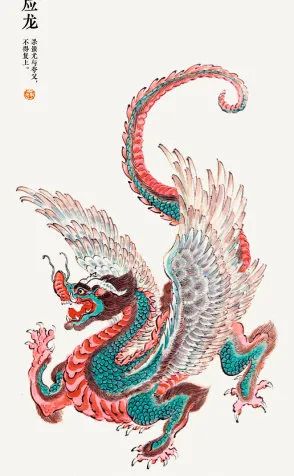
Ying Long. There are many records of Ying Long with wings in the Classic of Mountains and Seas, and the Map of Mountains and Seas: A Catalogue of Animals in the Classic of Mountains and Seas was painted by Li Yunzhong, People’s Literature Publishing House.
Ying Long defeated Chiyou first and then killed Kuafu, which made great contributions to the victory of the Yellow Emperor, but it also paid a heavy price for it. Shan Hai Jing Wild East longitude records that "Ying Long is in the South Pole, killing Chiyou and Kuafu", and he may also be weakened in the struggle, so he "can’t get back."(unable to return to heaven)",can only live in the northeast corner of the wild, there is a mountain called fierce plow mound". And the sky lacks the god of clouds and rain, so the drought in the lower bound has been going on for years. Shan Hai Jing Da Huang Bei Jing said that after Ying Long killed Kuafu, he "went to the south, so it was rainy in the south". Guo Pu said: "It’s a long story, and it’s similar to each other." That is, where the dragon goes, the precipitation goes.
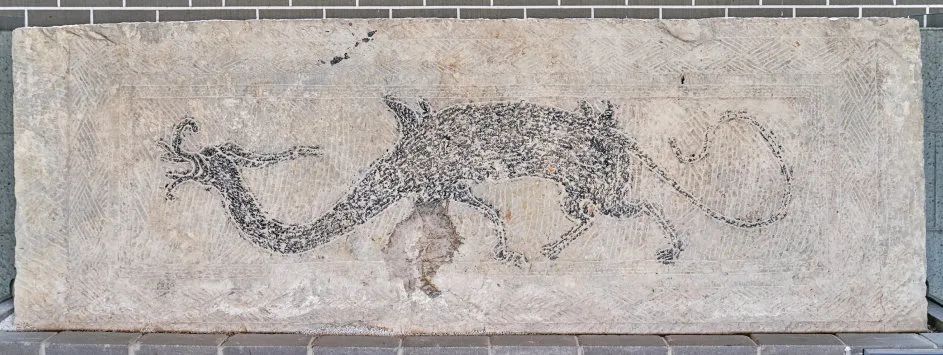
Two-wing Ying Long portrait brick, Han. Because Ying Long can make clouds make rain, when the drought is severe, people make Ying Long look like mud, sand and stones and pray.
Because Ying Long can make clouds make rain, when there is a serious drought, people make Ying Long look like mud, sand and stones, and pray, "Drought is like Ying Long, but heavy rain". In this way, there is another "earth dragon" in the dragon family, and the folk also have the custom of "repairing the earth dragon after drought". There are also many records about the earth dragon causing rain. Huai Nan Zi Shuo Shan Xun said that "saints use things, if they use Zhu Si to make friends with pigs, if they seek rain for the earth dragon".
As for the image and skills of Ying Long in ancient mythology, even Qu Yuan expressed doubts and feelings in Tian Wen: "What is Ying Long’s painting? What is the calendar of rivers and seas? " For this sentence, Wang Yi notes:
"When Yu treated the flood, a dragon painted the land with its tail. Those who guide the water should be decided, so they should be treated. "
HongXingZu note cloud:
"The" Mountain and Sea Classic Map "cloud, Xia Yu governs the water, and Ying Long draws the land with the tail."
The heckling words in "The Songs of the South" link Ying Long and Dayu’s water control. Dayu "tried his best to ditch the river and guide Sichuan and Yiyue", and Ying Long was ordered to open the way ahead. It draws the land with its tail, and wherever it is drawn, the river road it has opened extends to where it is drawn. If Dayu is a model of whole-hearted water control, then Ying Long can be regarded as the number one hero of Dayu’s charge. As for the realistic prototype of "Ying Long painted the land with the tail"(or the truth)Some scholars think that it is possible that Dayu got help from the clan with dragon totem in water control, or that it is a reflection of the joint water control of the clan with dragon totem; Mr Wen Yiduo thinks:
"The dragon who paints the land into a river is Yu himself, and the dragon who can paint the land into a river is the dragon who digs the river totem. It coexists with the ancestor Yu and is contradictory, so he sent the dragon as Yu’s teacher, saying that Yu’s method of water control came from the dragon."
In a word, such myths in Dayu’s water control are unlikely to be imagined out of thin air.
There are many dragons.
It is worth mentioning that the book Shu Yi Ji, written in the Southern Dynasties, also records:
"Hydra turned into a dumpling in 500 years, a dragon in 1,000 years, a horned dragon in dragon five in 100 years and a Ying Long in 1,000 years."
It can be seen that it takes thousands of years for Ying Long to grow up, which is the highest level of dragons-that’s why it grows wings. "Guang Ya Shi Guo" cloud:
"There are scales called dragons, wings called Ying Long, horns called a dragon, horns called a dragon, and dragons without horns called a dragon. Before ascending to heaven, they called a dragon."
It shows that the types of "dragons" described in ancient books are ever-changing and varied.
Although Shuo Yi Ji regards Jiao as the predecessor of Dragon, other ancient books don’t think so. The authoritative Shuo Wen Jie Zi clearly points out:
"Dumpling, the dragon is also. There are 3,600 fish in the pond, and the dumplings are long. "
There are many records about dumplings in Shan Hai Jing. For example, "Haineixijing" cloud:
"There are tree birds in Kaiming South, with six songs; Dumplings, scorpions, snakes, scorpions, leopards, and birds rank trees in the surface pond. "
Zhongshan Jing contains:
"Ten times once the first of jingshan mountain, yue wing at the mountain. Turbulent water flows out, and the east flows into the economy; When the water comes out, it flows to Han in the southeast, and many of them are awkward. "
Although these records only refer to "Jiao" but not "Dragon", in fact "Jiao" refers to "Dragon". Because Guo Pu said, "Dumplings are like snakes, with four legs and dragons."
From the records of Shan Hai Jing, Jiao(dragon)Living in all kinds of rivers. It didn’t leave a good impression in the minds of the ancients. According to the Records of Collected Notes, according to legend, during the Tang and Yao Dynasties, there was a big dumpling, "Three rivers overflowed and the sea was in the same stream", and its prototype was obviously an aquatic animal. In the famous story of "eliminating three evils around", one of the evils refers to "dumpling under the long bridge". Guo Pu commented:
"Dumpling is like a snake, but its four feet are small, its head is thin, its neck is covered with white scabies, and the big ones are more than a dozen. Its eggs are like a stone urn, which can swallow people."
These characteristics are easily reminiscent of crocodiles in reptiles. However, there is only one kind of crocodile living in China today, that is, the Chinese alligator living in the middle and lower reaches of the Yangtze River. However, this kind of animal has a mild temperament and there are few records of attacking people since ancient times. Obviously, this can’t be related to the dumpling that can swallow people. Fortunately, it is also recorded in the history books that there was an "alligator disaster" in the Hanjiang River Basin in Lingnan in the Tang Dynasty. When Han Yu, a famous writer in Tang Dynasty, was demoted to Chaozhou, he tried to warn crocodiles and throw pigs and sheep into evil streams.(now Hanjiang, Guangdong)Tell the crocodile to leave, otherwise it will be slaughtered, and write down the famous prose "Sacrificing Crocodiles". Since Han Yu mentioned that crocodiles "eat people, livestock, bears, roes, deer and roes to fatten their bodies", it shows that this kind of crocodile is not so docile as the Chinese alligator, but it is similar to the living habits of the Gulf Crocodile that still lives in Southeast Asia today. The latter is the largest reptile in the world, with a fierce temperament. It not only eats animals in the water, but also often hurts people ashore, posing a great threat to the production and life of the ancients. According to the latest research results, this crocodile, which was "infested everywhere" in the Tang Dynasty, is an extinct branch of the alligator, known as the Chinese Hanyu crocodile.(Hanyusuchus sinensis). Perhaps it was out of awe of this fierce crocodile that the ancients mixed with the concept of snakes and mythologized it as a "dragon".
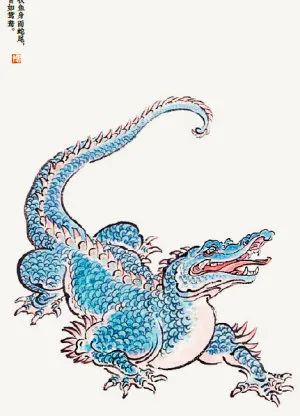
Tiger dumpling. Guo Pu commented that "a dumpling is like a snake, but its four feet are small, its head is thin, its neck is covered with scabies, and the big one is more than ten, and its eggs are like a stone urn, which can swallow people". These characteristics are easily reminiscent of crocodiles in reptiles.
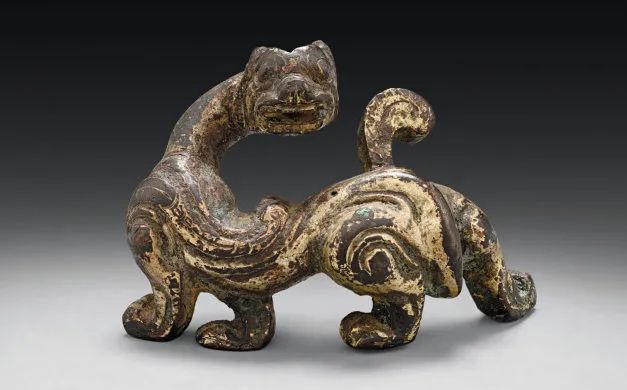
Bronze dragon, Han, now in the Cleveland Museum of Art, USA. Similar to Jiao, Jilong is also a hornless dragon. Shuowen said that it is "yellow if it is a dragon" or "it is said that it has no horns".
Similar to Jiao, Jilong is also a hornless dragon. Shuowen says that it is "yellow if it is a dragon" and "stinging if it has no horns". There is a story in Huainanzi that a dragon is better than a snake eel: one day, a red dragon is killed.(without horns)And a blue dragon.(angular)Roaming together, came to Jizhou ground. At this time, the weather is refreshing and the earth is stable. When a dragon and a dragon find delicious food, they eat it with relish. Because the range of activities is within 100 acres, it is despised and laughed at by a snake and an eel. They shouted, "Hey, dragon, dragon, dare you go to the river and sea with us?" A dragon and a dragon accepted the challenge, so "the wind and the freezing rain rocked up" and "moved the world and vibrated the sea", which scared the snakes and eels into the deep mud and dared not come out.
On the other hand, although dragons are miraculous, there is still a striking situation in ancient myths, that is, dragons are often used as the object of command by people with noble status. In this regard, "Shan Hai Jing" records that "Ju Mang in the East, birds and faces, take two dragons"; "Western Ru Shou, with a snake in its left ear, rides two dragons"; "Northern Yujiang, black hands and feet, riding two dragons"; "Zhu Rong in the south, a beast with a face, rides two dragons". Thus, the dragon is the mount of the four gods. Gao You also said in his note "Huai Nan Zi Tian Xun", "Ride by car every day, drive with six dragons, and xi he will conquer it."
In The Classic of Mountains and Seas, The Wild West Sutra, the ancient emperors were even seated on the dragon:
"Outside the southwest sea, south of Chishui and west of quicksand, there are two green snakes and two dragons, named Xia Hou Kai. If you go to heaven for three times, you will get the following nine arguments and nine songs. This field of great mu is 2,000 meters high, and it won the opening song "Nine strokes". "
Kai is the son of Yu and the first "hereditary" monarch in China’s ancient historical records. It goes without saying that in ancient mythology, this element of revealing identity through "Lapras", "Imperial Dragon" or "Driving Dragon" has also become a common means of deifying monarchical power in later generations.
References:
Pang Jin’s Exploration of loong Culture in 8,000 Years
The Origin and Evolution of Chinese Dragon Culture by Wang Liquan
A Study of the Word "Dragon" in Shan Hai Jing by Mei Shanying
The Dragon and Its Cultural Connotation in Shan Hai Jing by Gao Wang Fei.
关于作者